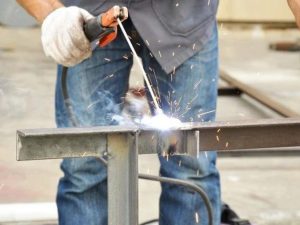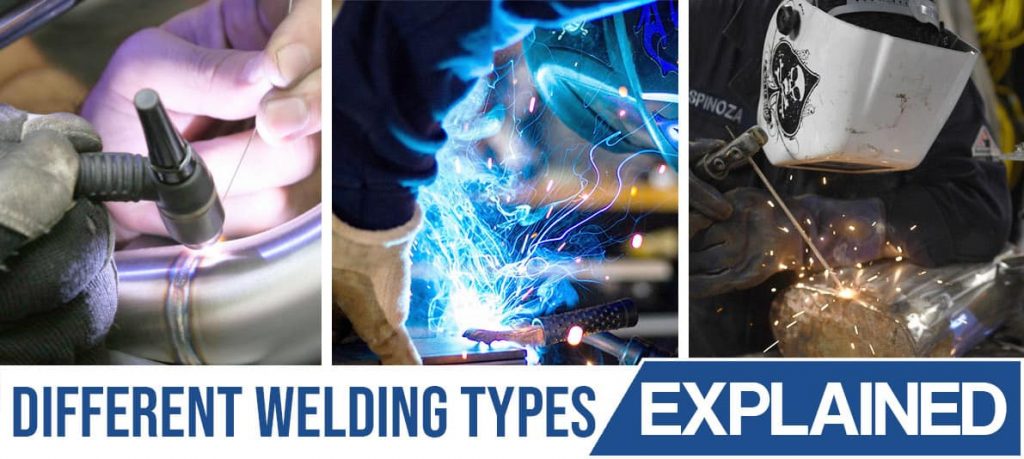Welding is a process that joins materials, usually metals or thermoplastics, by causing coalescence. This is often done by melting the workpieces and adding a filler material to form a pool of molten material (the weld pool) that cools to form a joint. There are different types of welding processes, including arc welding, resistance welding, and oxyfuel welding, that utilize different conditions and methods to weld various materials.
Different Types of Welding Processes
When it comes to welding, there are a variety of different processes that can be used to join two pieces of metal together. The type of welding process that you use will be determined by the materials that you are working with, the desired strength of the weld, and the environment in which the welding is taking place.
Arc Welding
Arc welding is a type of welding that uses electricity to create heat. The heat then melts the metal so that it can be joined together. There are two main types of arc welding: gas tungsten arc welding (GTAW) and gas metal arc welding (GMAW).
GTAW – also known as TIG Welding – uses a non-consumable tungsten electrode to produce the weld. Shielding gas is used, such as helium or argon, and this torch produces a very hot, concentrated arc. GTAW is mostly used for stainless steel and aluminum alloys because these metals do not conduct electricity well. This process can also be used on other metals; however, you will need to use an electrode made of another metal.
GMAW – also known as MIG Welding – uses a consumable wire electrode and an Argon-based shielding gas. An electric arc forms between the wire electrode and the base material to create heat, which then fuses the metals together. GMAW can be used on almost any metal but is commonly used for steel.

Resistance Welding
Resistance welding does not use any consumable materials; instead, it relies on electrical resistance to generate enough heat energy for joining two pieces of metal together. In this process, the current passing through the contact area between two pieces of metal creates enough heat energy to melt the metals at those points so that they can fuse together upon cooling.
There are four main types of resistance welding: spot welding, seam welding, flash welding, and projection welding.
Spot Welding
Spot welding works by using electrical current to flow through the metal and create heat. The heat generated by the electrical current melts the metal, which allows the two pieces of metal to be joined together. The spot welding process is controlled by an operator who sets the amount of time, pressure, and current that is applied to the metal.
The spot welding process can be done with either an AC or DC power source. AC power is typically used for thin metals, while DC power is used for thicker metals. The type of power source that you use will determine the amount of time, pressure, and current that you need to apply to the metal.
What Are the Advantages of Spot Welding?
Spot welding has a number of advantages over other types of welding, such as MIG welding and TIG welding. Spot welding is a fast and efficient way to weld two pieces of metal together. It also requires less skill than other types of welding, which makes it a good choice for beginner welders. Additionally, spot welding can be done with relatively simple equipment, which makes it a more affordable option than other types of welding.
What Are the Disadvantages of Spot Welding?
Spot welding does have some disadvantages. One disadvantage is that it can only be used on certain types of metals. Another disadvantage is that spot welds are not as strong as MIG or TIG welds. Finally, spot welds are more likely to break than MIG or TIG welds if they are subjected to stress or vibration.
Seam Welding
Seam welding is a type of resistance welding. This means that the process uses electrical current to generate heat. The current is passed through the weld area, which heats up the metal and causes it to melt. Once the metal has melted, pressure is applied to fuse the two pieces together. The entire process usually takes just a few seconds.
Seam welding can be performed using either an AC or DC power source. AC welding is often used for thinner materials, as it produces less heat than DC welding. DC welding is typically used for thicker materials, as it produces more heat and can penetrate deeper into the metal.
What Are the Benefits of Seam Welding?
Seam welding offers a number of benefits over other types of welding, such as:
-It produces strong welds that are resistant to shock and vibration
-It can be used on a variety of materials, including aluminum, steel, and stainless steel
-It is a fast welding method that is ideal for mass production
-It is less likely to cause distortion in the weld area
-It creates minimal sparks and fumes, making it a safer option than other welding methods
Flash Welding
Flash welding is a type of thermal welding that uses heat to fusion two pieces of metal together. The weld area is heated to its melting point by an electric arc, and then brought into contact with a pressure pad. As the weld area cools, it forms a metallurgical bond between the two pieces of metal.
This type of welding is highly efficient and can be used to join most types of metals, including stainless steel, aluminum, and even titanium. Flash welds are also frequently used in the automotive industry to create lap joints for car doors and fenders.
One of the advantages of flash welding is that it produces very little debris or slag. This makes it ideal for use in clean rooms or other environments where debris could cause contamination. Additionally, flash welding can be performed quickly and easily, making it a cost-effective method for joining metals.
Are There Any Disadvantages to Flash Welding?
While flash welding does have several advantages, there are also some disadvantages to consider. One downside is that flash welding can only be used on metals that have matching coefficients of thermal expansion. If the coefficients don’t match, the materials will expand or contract at different rates as they’re heated and cooled, which could cause cracking or warping.
Another potential disadvantage is that metals with a high carbon content can produce dangerous fumes when heated. These fumes can contain carcinogens, so proper ventilation must be used when performing flash welds on high-carbon materials.
Projection Welding
Projection welding is a type of resistance welding used to join metals. In this process, two pieces of metal are joined together by heat and pressure generated by an electric current passing through them. The area where the weld will be made is first cleaned and then the two pieces of metal are clamped together. One electrode is placed on each side of the joint. Acontroller supplies the current to the electrodes and regulates the amount of time that the current flows. When the current is turned on, it passes through the joint and heats the metal, causing it to melt and form a weld.
As with any welding process, there are advantages and disadvantages to projection welding. However, there are more advantages than disadvantages, making projection welding a great choice for many applications.
Here are some of the advantages of projection welding:
-The parts to be welded do not have to be held in very tight tolerances since only a small area is heated at one time. This makes it ideal for joining parts that have already been machined or formed.-Welds can be made quickly since only a small area is heated at one time.-The process is very versatile and can be used on a variety of metals, including aluminum, copper, and stainless steel.-There is a minimal distortion of the parts being welded since only a small area is heated.-The process is highly automated and very repeatable, making it possible to produce large volumes of parts with consistent quality.-Projection welding can be performed in various orientations, including horizontal, vertical, and overhead positions.-Specialty alloys can also be welded using this process.
Oxy-Fuel Welding
Oxy-fuel or oxygen cutting torches use fuel gases such as acetylene or propane and oxygen to generate enough heat energy for cutting or joining thicker pieces of metal (usually greater than 1/8 inch). In oxy-fuel cutting torches, oxygen combines with fuel gases such as acetylene or propane at extremely high temperatures – up to 6000 degrees Fahrenheit! The oxygen-fuel flame produced by these torches can cut through most steel quickly; however, it cannot be used on aluminum or stainless steel..
Conclusion:
There are plenty of different types of welding available for different circumstances – so choosing which one suits your needs best depends entirely on what project you’re working on! If you’re looking for more detail about each process including recommended applications and safety information.
Welding is a process of joining two materials together by melting them and using a filler material to create a strong bond. There are many different types of welding, each with its own advantages and disadvantages. The type of welding you choose should be based on the project you’re working on, the materials you’re using, and your own personal preferences.

